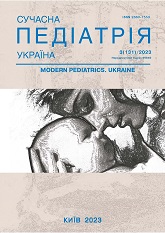A case of mitochondrial episodic myopathy (variant without optic atrophy and reversible leukoencephalopathy) in the Carpathian region
DOI:
https://doi.org/10.15574/SP.2023.131.134Keywords:
mitochondria, myopathy, episodes, lactic acidosis, ketoacidosis, FDX2 gene, reversible leukoencephalopathyAbstract
Mitochondrial episodic myopathy with/or without optic nerve atrophy and reversible leukoencephalopathy (MEOAL, OMIM 251900) belongs to rare primary mitochondrial myopathies, caused by nuclear genome DNA mutations with autosomal recessive inheritance.
Purpose - to inform about the case of this current rare mitochondrial miopathy and encrease the knowledge of practical doctors in scope of diagnostics and treatment of the current orphan pathology.
Clinical case. In the clinical case being presented herein, the sick child had a severe course of the disease in the form of episodes of severe myopathy (during one of them there was a need for long-term mechanical lungventilation with the placement of a tracheostomy) in combination with severe metabolic crises. During crises, persistent keto- and lactic acidosis, a sharp increase in transaminases (alanine aminotransferase and aspartate aminotransferase) and creatine kinase in blood serum were observed. The patient did not have optic nerve atrophy or leukoencephalopathy. A similar course of the disease is described in the literature by different authors in only 3 cases. Molecular genetic analysis (Invitae laboratory, San Francisco) revealed 2 mutations of the FDX2 gene (the disease is associated with this gene) with uncertain pathogenic significance. Considering the presence of cardinal symptoms of MEOAL, this diagnosis was set to the patient, and therefore the detected mutations of the FDX2 gene should be considered as pathogenic.
Conclusions. A thorough syndromic analysis of the phenotype together with a set of paraclinical examinations, including modern molecular genetic methods, made it possible to establish a clinical diagnosis of an extremely rare primary mitochondrial myopathy, which will contribute to further elucidation of relationships in the «genotype-phenotype» system and, possibly, reclassification of pathogenic genotypes in modern databases, as well as finding optimal approaches in treatment and rehabilitation of patients.
The research was carried out in accordance with the principles of the Helsinki Declaration. The informed consent of the patient was obtained for conducting the studies.
No conflict of interests was declared by the authors.
References
Aggarwal A, Pillai NR, Billington C, Schema L, Berry S. (2021-2022). Rare presentation of FDX2-related disorder and untargeted global metabolomics findings. American Journal of Medical Genetics. Part A. Medicine, Biology. 88 (4): 1239-1244. https://doi.org/10.1002/ajmg.a.62608; PMid:34905296
Coleman RF, Nienhuis AW, Brown WJ, Munsat TL, Pearson CM. (1967). New myopathy with mitochondrial enzymehyperactivity. JAMA. 199: 624-630. https://doi.org/10.1001/jama.199.9.624; PMid:6071254
Gurgel-Giannetti J, Lynch DS, Paiva ARB, Lucato LT, Yamamoto G, Thomsen C et al. (2018). A novel 614585 complex neurological phenotype due to a homozygous mutation in FDX23. Brain. 141: 2289-2298. https://www.omim.org/entry/251900?search=episodic%20mitochondrial%20myopathy%20with%20or%20without%20optic%20atrophy%20and%20reversible%20leukoencephalopathy&highlight=atrophy%20episodic%20leukencephalopathic%20leukencephalopathy%20leukoencephalopathic%20leukoencephalopathy%20mitochondrial%20myopathic%20myopathy%20optic%20reversibility%20reversible%20twosided%20with%20without.
OMIM. (2012). Ferredoxin 2; FDX2. Contributors: Cassandra L. Kniffin - updated: 03/21/2019. Creation Date:Patricia A. Hartz : 04/20/2012, carol : 03/25/2019. URL: https://www.omim.org/entry/614585?search=episodic%20mitochondrial%20myopathy%20with%20or%20without%20optic%20atrophy%20and%20reversible%20leukoencephalopathy&highlight=atrophy%20episodic%20leukencephalopathic%20leukencephalopathy%20leukoencephalopathic%20leukoencephalopathy%20mitochondrial%20myopathic%20myopathy%20optic%20reversibility%20reversible%20twosided%20with%20without.
OMIM. (2020). #251900 Mitochondrial myopathy, episodic, with or without optic atrophy and reversible leukoencephalopathy Creation Date: Victor A. McKusick: 06/04/1986, Edit History: carol: 01/03/2020. URL: https://www.omim.org/entry/251900.
OMIM. (2023). An Online Catalog of Human Genes and Genetic Disorders. URL: https://www.omim.org/.
Price HM, Gordon GB, Munsat TL, Pearson CM. (1967). Myopathy with atypical mitochondria in type I skeletal muscle fibers: a histochemical and ultrastructural study. J. Neuropath. Exp. Neurol. 26: 475-497. https://doi.org/10.1097/00005072-196707000-00009; PMid:5338697
Sheftel AD, Stehling O, Pierik AJ, Elsasser H-P, Muhlenhoff U, Webert H, Hobler A, Hannemann F, Bernhardt R, Lill R. (2010). Humans possess two mitochondrial ferredoxins, Fdx1 and Fdx2, with distinct roles in steroidogenesis, heme, and Fe/S cluster biosynthesis. Proc. Nat. Acad. Sci. 107: 11775-11780. https://doi.org/10.1073/pnas.1004250107; PMid:20547883 PMCid:PMC2900682
Spiegel R, Saada A, Halvardson J, Soiferman D, Shaag A, Edvardson S et al. (2014). Deleterious mutation in FDX1L gene is associated with a novel mitochondrial muscle myopathy. Europ. J. Hum. Genet. 22: 902-906. https://doi.org/10.1038/ejhg.2013.269; PMid:24281368 PMCid:PMC4060119
Downloads
Published
Issue
Section
License
Copyright (c) 2023 Modern pediatrics. Ukraine

This work is licensed under a Creative Commons Attribution-NonCommercial 4.0 International License.
The policy of the Journal “MODERN PEDIATRICS. UKRAINE” is compatible with the vast majority of funders' of open access and self-archiving policies. The journal provides immediate open access route being convinced that everyone – not only scientists - can benefit from research results, and publishes articles exclusively under open access distribution, with a Creative Commons Attribution-Noncommercial 4.0 international license (СС BY-NC).
Authors transfer the copyright to the Journal “MODERN PEDIATRICS. UKRAINE” when the manuscript is accepted for publication. Authors declare that this manuscript has not been published nor is under simultaneous consideration for publication elsewhere. After publication, the articles become freely available on-line to the public.
Readers have the right to use, distribute, and reproduce articles in any medium, provided the articles and the journal are properly cited.
The use of published materials for commercial purposes is strongly prohibited.

